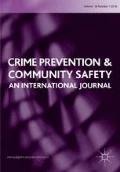Abstract
Partnerships between the police and the wider community to tackle safety issues are a cornerstone of contemporary thinking about policing. Using data from two studies into community safety partnerships in Northern Ireland and Scotland, this article argues that the level of policing ‘with’ the community varies greatly depending on the particular safety issue that is being addressed. Using Osborne and Gaebler’s (Reinventing government: how the entrepreneurial spirit is transforming the public sector, Plume, New York, 1991) metaphor, I argue that there is a spectrum of issues that moves from inevitably high levels of unilateral police action where the police retain firm control over ‘steering’ and ‘rowing’ functions, towards issues that enjoy higher levels of police–community collaboration where ‘steering’ and ‘rowing’ can be shared more democratically. Outlining such a spectrum can help clarify the suitable expectations of what community safety partnerships can practically achieve.

Similar content being viewed by others
References
Brunger, M. 2011. Governance, accountability and neighbourhood policing in Northern Ireland: analysing the role of public meetings. Crime Law and Social Change 55: 105–120.
Brunger, M. 2012. Dispatches from the field: Developing community safety in Northern Ireland. Crime Prevention and Community Safety 14 (2): 140–164.
Criminal Justice Inspection Northern Ireland. 2014. Policing and community safety partnerships: A review of governance, delivery and outcomes. Department of Justice. Available online: http://cjini.org/CJNI/files/aa/aacda6ac-11fa-4d0a-944a-4ba2cd4eed28.pdf. Accessed 29 Nov 2016.
Ellison, G., and M. O’Rawe. 2010. Security governance in transition: The compartmentalizing, crowding out and corralling of policing and security in Northern Ireland. Theoretical Criminology 14 (1): 31–57.
Ellison, G., P. Shirlow, and A. Mulcahy. 2012. Responsible participation, community engagement and policing in transitional societies: Lessons from a local crime survey in Northern Ireland. The Howard Journal of Criminal Justice 51 (5): 488–502.
Gasper, R., and A. Davies. 2016. Revisiting the potential of community empowerment within UK neighbourhood policing meetings. Policing and Society. (Online first).
Gilling, D. 2008. Celebrating a decade of the Crime and Disorder Act? A personal view. Safer Communities 7 (3): 39–45.
Harkin, D. 2015a. Simmel, the police form and the limits of democratic policing. British Journal of Criminology 55: 730–746.
Harkin, D. 2015b. Police legitimacy, ideology and qualitative methods: A critique of procedural justice theory. Criminology and Criminal Justice 15 (5): 594–612.
Hays, R.A. 2012. Policing in Northern Ireland: Community control, community policing and the search for legitimacy. Urban Affairs Review 49 (4): 557–592.
Herbert, S. 2006. Citizens, cops and power. Chicago: University of Chicago Press.
Hope, T. 1995. Community crime prevention. Crime and Justice 19: 21–89.
Hughes, G. 2007. The politics of crime and community. Hampshire: Palgrave Macmillan.
Hughes, G., and M. Rowe. 2007. Neighbourhood policing and community safety: Researching the instabilities of local governance of crime, disorder and security in contemporary UK. Criminology and Criminal Justice 7 (4): 317–346.
Independent Commission on Policing for Northern Ireland. 1999. A new beginning: Policing in Northern Ireland. Available online http://cain.ulst.ac.uk/issues/police/patten/patten99.pdf. Accessed 29 Nov 2016.
Kappeler, V., and P. Kraska. 1998. A textual critique of community policing: Police adoption to high modernity. Policing: An International Journal of Police Strategies and Management 21 (2): 293–313.
Kilpatrick, C. 2014. Two ‘punishment-style’ attacks carried out every week in Northern Ireland. Belfast Telegraph (3/11/2014) Available online http://www.belfasttelegraph.co.uk/news/northern-ireland/two-punishmentstyle-attacks-carried-out-every-week-in-northern-ireland-30712724.html. Accessed 8 Nov 2016.
Manning, P. 2011. Democratic policing in a changing world. Boulder: Paradigm Publishers.
McCarthy, D., and M. O’Neill. 2014. The police and partnership working: Reflections on recent research. Policing: A Journal of Policy and Practice 8 (3): 243–253.
Myhill, A. 2007. Police authorities’ public accountability role: Learning from three community engagement projects. Policing 1 (2): 173–183.
Northern Ireland Policing Board. 2016. Policing and community safety partnerships (website). Available online https://www.pcsps.org/. Accessed 29 Nov 2016.
Osborne, D., and T. Gaebler. 1991. Reinventing government: How the entrepreneurial spirit is transforming the public sector. New York: Plume.
RTE. 2016. 27 Paramilitary-style NI attacks in 2016—Villiers. RTE (30/6/2016) Available online http://www.rte.ie/news/2016/0630/799233-villiers-paramilitary-attacks/. Accessed 8 Nov 2016.
Skinns, L. 2008. A prominent participant? The role of the state in police partnerships. Policing and Society 18 (3): 311–321.
Skogan, W. 2006. Police and community in Chicago: A tale of three cities. Oxford: Oxford University Press.
Topping, J. 2008. Diversifying from within: Community policing and the governance of security in Northern Ireland. British Journal of Criminology 48: 778–797.
Topping, J., and J. Byrne. 2016. Shadow policing: The boundaries of community-based ‘policing’ in Northern Ireland. Policing and Society 26 (5): 522–543.
Torney, K. 2015. Above the law: paramilitary ‘punishment’ attacks in Northern Ireland. The Detail (22/3/2015) Available online http://www.thedetail.tv/articles/above-the-law-paramilitary-punishment-attacks-in-northern-ireland. Accessed 8 Nov 2016.
Virta, S., and M. Branders. 2016. Legitimate security? Understanding the contingencies of security and deliberation. British Journal of Criminology 56: 1146–1164.
Young, D. 2016. Belfast man shot in legs during paramilitary-style attack, Belfast Telegraph (7/11/2016) Available online http://www.belfasttelegraph.co.uk/news/northern-ireland/belfast-man-shot-in-legs-during-paramilitarystyle-attack-35193649.html. Accessed 8 Nov 2016.
Author information
Authors and Affiliations
Corresponding author
Rights and permissions
About this article
Cite this article
Harkin, D. Community safety partnerships: the limits and possibilities of ‘policing with the community’. Crime Prev Community Saf 20, 125–136 (2018). https://doi.org/10.1057/s41300-018-0042-y
Published:
Issue Date:
DOI: https://doi.org/10.1057/s41300-018-0042-y




